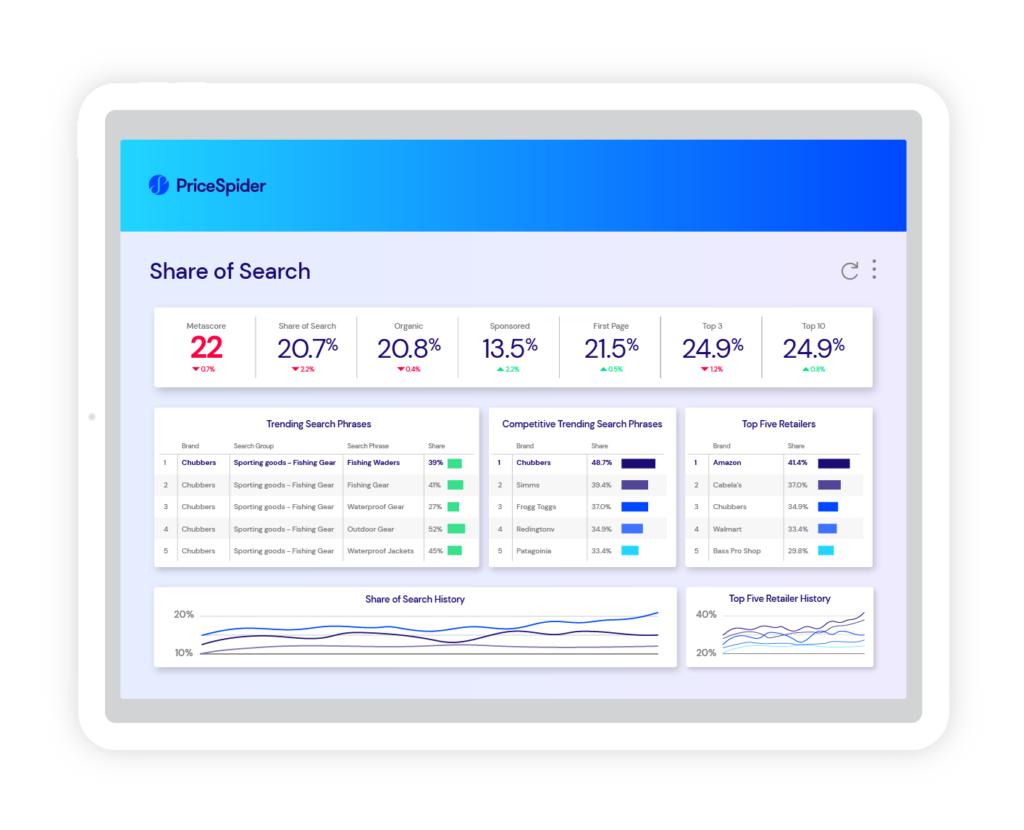The new trilogy of Star Wars movies is bad. There, we said it. But look at the incredible special effects and breakneck pace, you may argue. Well in spite of all the technical advancements of filmmaking since “Episode IV” premiered decades ago, a compelling story still remains core to the moviegoing experience.
Online shopping is no different. Even though we can buy diapers from the peak of Everest using the supercomputer in our pocket (and they will arrive the next day), it doesn’t mean the rules of selling are suddenly flipped upside down. Premium customer experiences still win the day.
Digital shelf monitoring is how ecommerce brands track key metrics on retail websites. It allows them to analyze product page performance and identify opportunities to improve rankings, optimize ad spend, and increase brand integrity.
On the physical shelf inside a brick-and-mortar store, how and where your products are displayed can have a huge impact on how customers perceive them, especially in relation to your competitors. The digital shelf is the online equivalent.
There are no aisles on a retailer’s website or online marketplace, but there is a search bar. Categories, filters, and other tools to help customers find the products they’re looking for. As shoppers move from one retailer’s digital shelf to another, brands need to ensure a consistent experience with their digital assets. On every “shelf,” the brand and product should look and feel the same.
For every product in your catalog and every seller who carries your product, there’s a lot to keep track of — product titles, descriptions, images, ratings, price, stock, and more. The scope and importance of digital shelf monitoring leads many brands to digital shelf software to reduce tedious manual processes. Without it, you could easily spend all of your time tracking information and opportunities for thousands of products across hundreds of websites.
Here are the nuts and bolts of digital shelf monitoring, which a solution like Brand Monitor can handle for you.
Content compliance monitoring
The more websites your products appear on, the harder it is to keep track of every product title, description, images, videos, and other content that goes with each SKU. However, it’s critical that you monitor each product page for variations.
At best, outdated images and assets will underperform, because your new assets were optimized for a specific goal. At worst, they’ll lead customers astray, giving them incorrect information or an incorrect visual representation of your product. They may assume it does things it can’t or that it can’t do things it does! They may also expect it to look different or be made from a different material.
Content compliance monitoring ensures that the assets associated with a SKU are the same everywhere the SKU appears. Brand Monitor does this by comparing each product page to a “master copy,” flagging any variations and assigning each page a score.

Search monitoring
Every brand wants to be the most prominent choice in their category. The top choice is always changing. Ecommerce brands must pay attention to their products’ positions in search engine results for all terms and phrases that matter to that product. It could be dozens of keywords for each product, and they must be tracked on each site you sell through.
Brand Monitor tracks your position over time for the keywords that are most relevant to your products, distinguishing between results earned organically and ones you paid for with sponsored ads with its Share of Search Module. No need to check your position every day, but it is a digital shelf metric you should monitor, particularly when you make major product page updates. You can also monitor competitors’ position for these same keywords, even which terms they’re advertising for.
Price monitoring
It’s normal to see some variation in pricing from one site to another. As customers shop around, they quickly get a sense of what the “regular” price is. So when sellers violate your minimum advertised pricing (MAP) policy, it can create huge fluctuations that leave customers unsure which products are legitimate. They dig deep into your margins and damage your relationships with other sellers. Some sellers want to respect your policy but feel forced to violate it in order to compete.
Employees can’t watch your product pages all the time, but software can. A digital shelf analytics solutions such as Brand Monitor and MAP monitoring software such as Prowl crawl your product pages in real time and notify you anytime a price violates your policy.
Stock availability monitoring
Products go in and out of stock all the time. If you’re not monitoring your products’ stock availability and your competitors’, you’ll miss some valuable opportunities.
Any time your products go out-of-stock, your customers simply can’t buy them. Why waste money driving people to a page they’re unable to purchase from? Save your ad spend for products people actually can buy. Turn the ads back on when the item is available again.
When your competitors go out-of-stock, you have a similar opportunity. Their customers can’t buy. Normally, it would be risky to advertise on a competitor’s branded search terms. People who search for your competitors by name aren’t likely to click on your page in the results. But if those competitors aren’t available, it’s a whole different ballgame. Advertising on these keywords while their products are out-of-stock makes your product the first available alternative.
By using tools such as Brand Monitor to monitor stock availability, you identify new ways to optimize your ad budget, eliminating waste and targeting your competitors when they’re vulnerable.
Ratings monitoring
Your overall ratings may not change much month-to-month. However, during short periods of time, a sudden spike in negative or positive ratings could mean there’s something you need to address. There might be a problem with your carrier that customers are blaming you for. Perhaps there was mention of your brand somewhere that created unrealistic expectations of what your product is capable of.
Monitoring your ratings is critical in learning how your products are perceived right now, not just overall. Of course you should always be working to improve and protect your overall ratings too.
Start monitoring the digital shelf
There’s a lot to pay attention to on the digital shelf. With the right tools, you can reap the benefits of comprehensive monitoring without opening thousands of tabs and spending all your time clicking refresh.
Brand Monitor collects and organizes data from the digital shelf so that you always have eyes and ears on the sites and pages you want to monitor.
Want to see what digital shelf monitoring can do for your brand?
Schedule a demo of Brand Monitor today.

